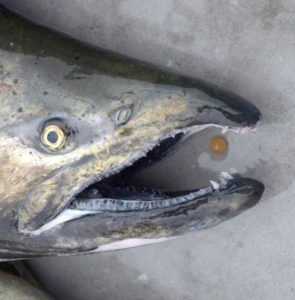By KEVIN NAZE
Correspondent
If you’re one of the thousands of Packerland anglers who fish salmon and trout on Lake
Michigan or Green Bay, the DNR wants to hear from you.
Earlier this week, Michigan announced a proposed 54 percent increase in Chinook salmon stocking beginning in 2023.
That follows decades of reductions in Michigan, where increased natural reproduction is thought to produce nearly 75% of the salmon that are caught.
Stocking cutbacks by multiple states have allowed alewives — the favored forage of salmon and trout on Lake Michigan — to recover enough to produce six year classes of baitfish.
This abundance of food has produced some of the heaviest predators ever caught, including a record Chinook in Michigan last summer and the first 40-pound “king” salmon in nearly three decades in Wisconsin waters this July.
Wisconsin is looking at a new three-year stocking plan beginning next spring.
It last raised its annual goal for Chinook stocking 50 percent in the 2020-2022 plan, but due to hatchery issues fell short of the goal of 1.2 million kings this year.
To make up for the shortfall, the DNR hopes to add hundreds of thousands of additional fingerling steelhead (rainbow trout) this fall.
Comments on Wisconsin’s 2023-2025 salmon and trout stocking plan are due by Oct. 1.

You can find a link, along with presentations from a recent meeting, at dnr.wisconsin.gov/topic/Fishing/lakemichigan/LakeMichiganSalmonandTroutMeetings.
Meanwhile, Michigan DNR Lake Michigan basin coordinator Jay Wesley said although the alewife biomass is a fraction of what it was decades ago, there’s a strong 2021 year-class and five other year-classes seen in fisheries surveys.
Michigan is proposing an annual increase to one million spring fingerling Chinooks starting next year.
It will host a virtual meeting from 7-8:30 p.m. (Eastern) Monday, Sept. 19, to discuss and receive feedback.
The Michigan DNR works with the Lake Michigan Committee, which is represented by the states that border the lake (Illinois, Indiana, Michigan and Wisconsin) and the Chippewa-Ottawa Resource Authority, to co-manage the fishery in Lake Michigan.
You can Google MDNR Chinook salmon stocking webinar (passcode is 2022), or join via phone at 646-876-9923 or 301-715-8592 (webinar ID is 994 1124 7153).
Charter reporting
The Wisconsin DNR is seeking public comment on a proposed rule that would require daily electronic harvest reporting for all Lake Michigan and Lake Superior charter fishers, meaning those required to hold an outlying water sport trolling license.
It would replace the current paper reporting system.
Accurate harvest records are important, and electronic reporting would provide real-time harvest data.
An electronic reporting system was implemented in January 2022 for the DNR’s Great Lakes Fishing guide program.
The Zoom meeting begins at 6 p.m. Monday.
You can register for it at us02web.zoom.us/meeting/register/tZUkf-2oqz8jG9MJ_LudibnXW9S_lDIi2pCy.
Alternatively, you can join by phone: 1-312-626-6799 (Meeting ID is 819 8405 4917).
The WDNR will accept written comments on the proposed rule until 11:59 p.m. Sept. 19 via email: [email protected].
Where to hunt
Learn about public lands open to hunting and get tips on accessing private land during a free online webinar at 7 p.m. Sept. 21.
The DNR, in partnership with the National Wild Turkey Federation, Pheasants Forever and Becoming an Outdoorswoman, is running the event.
It’s the third in a series designed for those interested in learning about hunting, fishing and trapping.
Following a brief presentation and panel discussion, the audience will have opportunities to ask questions.
The webinar will be recorded and can be viewed on YouTube any time.
The link to watch is www.youtube.com/watch?v=iT3j1aG0jDA.
For more information on hunting public lands in Wisconsin, visit dnr.wisconsin.gov/topic/lands.
DNR Deer Specialist Jeff Pritzl said public lands can hold amazing opportunities, but hunting public land can come with obstacles if you don’t scout in advance.
“The adventure is rewarding for the same reasons that it is difficult,” Pritzl said.
As always, the DNR is reminding anyone using public lands to be respectful of others.
Hunters should have backup plans to keep them afield in the event they overlap with another hunter.
Weekly fishing report
Walleye fishing on Green Bay is excellent
Good catches of 15-20 inch eating size fish, with bigger fish up to 30” are being taken around Bayshore Park, Vokes reef, Vincent Point, Geanos Reef, Maccos Reef, 2 Mile Reef, and in the mud off the spark plug.
A good bite is just starting to develop in University Bay, Suamico and Deadhorse Bay.
Casting ripper minnows, shiver minnows and jigging Rapalas are all taking fish.
Trolling crankbaits in and around the reefs has been my go-to presentation.
Out in deeper water, crawler harnesses and crank baits on snap weight programs have been a sure way to put fish in the boat.
Perch fishing is good, with nightcrawlers and minnows being the best presentation.
The edges of the shipping channel, out in front of the Bayshore Park launch and the Geanos Reef area are giving up the most perch.
Musky fishing has picked up and will continue to get better as the waters of the Bay cool. Trolling blades, swim baits, and crankbaits are taking these fish.
Shore fishing is also picking up as the bait fish are making their way into the river systems, with many predictor fish following them in.
If you get the chance to go, please be safe and make sure you take a kid fishing.
For more information where to fish and what to use, give us a call at 920-593-1749.
Yah, only at Smokeys!!!
Capt. Jerry Ruffolo
Anglers Plus Guide Service
920-973-2868
